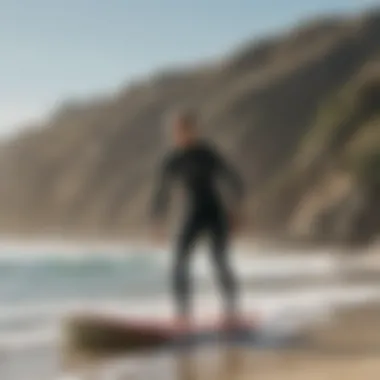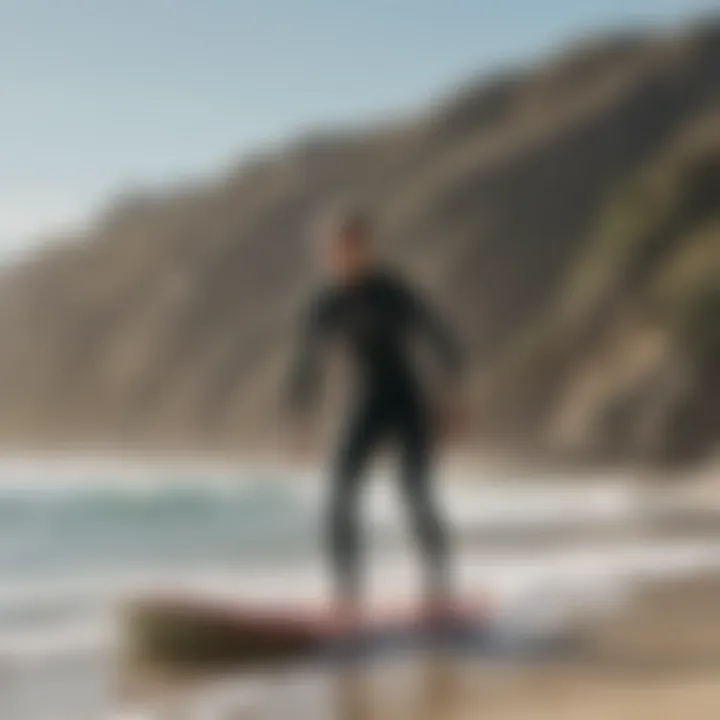Discovering California's Surf Beaches: A Complete Guide


Intro
Surfing in California is more than just a sport; it's a way of life that encapsulates the spirit of adventure and freedom. From the rolling waves of Malibu to the hidden coves of Santa Cruz, each surf beach is a unique canvas where riders paint their stories. For both seasoned surf veterans and eager novices, understanding the landscape of California surf beaches is vital to making the most of every wave. In this article, we'll thoroughly explore the varied surf spots, unearthing not just the popular gems but also those tucked away from the bustling crowds.
You'll find insights into the best times to visit, the typical wave patterns, and elements of surf culture that shape the experience of riding the waves. Knowing what gear to bring and how to respect the ocean's etiquette are essential for successful surfing adventures. Whether you're looking to improve your skills or simply enjoy the beauty of the Californian coastline, this guide is here to steer you on the right path.
Gear Essentials
Top Picks for Watersports Equipment
When it comes to surfing, having the right gear is crucial. It's not just about style; it impacts performance and safety. Here are some of the top must-haves:
- Surfboard: Consider what type of board suits your surfing style. Longboards are ideal for beginners, offering stability and ease, while shortboards are suited for those who crave speed and agility.
- Wetsuit: California's waters can get chilly, especially in the winter months. A good-quality wetuit, typically made of neoprene, helps keep you warm while maintaining flexibility. Look for suits rated for temperature—3/2mm suits work well for most coastal areas.
- Leash: This piece of equipment is often overlooked but is vital for safety. A leash connects you to your board, ensuring that it doesn't drift away if you fall. Make sure to choose one that matches the length and thickness of your board.
- Wax: Surfboard wax is essential for grip. The right type helps your feet stay planted on your board during rides. Applying wax before hitting the surf can make a world of difference in performance.
Maintenance and Care Tips for Gear
Caring for your gear prolongs its lifespan and ensures optimal performance. Here are some handy tips:
- Rinse Your Gear: After each session, rinse your surfboard and wetsuit in fresh water to remove salt and sand, which can degrade materials over time.
- Store Properly: Keep your board out of direct sunlight when not in use to prevent warping. A board bag is a good investment.
- Regular Inspections: Check your gear regularly for signs of wear and tear. Look for dings, delamination, or worn spots in your wetsuit.
Proper maintenance of your surfing gear not only enhances your performance but also lets you enjoy the ocean longer.
Techniques and Tips
Beginner Tips for Each Watersport
If you're just dipping your toes into the surfing world, consider these foundational tips:
- Choose the Right Beach: Head to beginner-friendly spots like La Jolla Shores or Pismo Beach, where wave conditions are gentler.
- Practice Paddling: Get comfortable paddling before trying to stand. Find your balance and learn how to pop up smoothly, ideally when the waves come to you.
- Watch the Locals: Spend some time observing seasoned surfers. Note how they position themselves and the way they read the waves.
Advanced Techniques for Skill Enhancement
For those looking to take it up a notch, focusing on technique can lead to notable improvements:
- Wave Selection: Learning how to choose the right wave sets you apart. Aim for waves that break consistently and seem manageable.
- Carving Turns: Work on your bottom turns and learn to carve for more control on your board. Drift in and out of the wave face to refine this skill.
- Speed Generation: To generate speed, practice pumping—using your knees and upper body to propel yourself forward on the board.
With this foundational knowledge about gear essentials and techniques, you're set to navigate the vibrant world of California's surf beaches with confidence and flair. Next, we’ll dive deeper into the exhilarating experiences that California has to offer.
Preface to California's Surf Culture
California’s surf culture isn’t just a hobby; it’s a rich tapestry woven with the threads of history, lifestyle, and community. In this part of the article, we'll delve into the significance of this culture and see how it shapes the experiences of surfers across the coastline. Surfing here showcases more than wave riding—it's a lifestyle that encompasses an entire way of living, thinking, and connecting with the ocean.
Historical Context
The roots of California's surf culture can be traced back to the early 20th century when a handful of pioneers began what would become a tidal wave of enthusiasm for surfing. These early surfers were influenced by Polynesian traditions, embracing the ocean as more than just a leisure spot. In the post-war era, surfing began to grow more popular with the establishment of surf schools and the first surf clubs.
By the 1960s, surfing had become a cultural phenomenon—think surfboards plastered with vibrant art, beach parties, and an explosion of surf music. Much like a snowball rolling down a hill, the movement gained momentum, influencing everything from fashion to film. Films like "Endless Summer" and songs by The Beach Boys depicted the surf lifestyle, bringing it into the limelight. California started to be seen as a surfing mecca, attracting people from all walks of life, eager to tackle those famous swells.
Surfing isn’t just about catching a wave; it's about understanding the natural world and becoming part of it. It’s a culture that connects generations, fostering friendships and bonds through shared experiences, whether it be riding the big waves or just hangin' out by the shore.
Surfing as a Lifestyle
For many, surfing transcends the act of riding waves. It’s a lifestyle that embodies freedom, individuality, and a connection to nature. Surfers tend to adopt an ethos of environmental consciousness. Many are advocates for ocean conservation, understanding that their love for surfing goes hand-in-hand with a responsibility to protect the sea.
Life near the coast is often intertwined with surfing routines. Many surfers wake up at the crack of dawn, scoping the horizon for the perfect wave. The local tide charts and swell forecasts become as familiar as their favorite coffee shops.


Beyond the technical aspects of catching waves, surfers cultivate a unique identity. Symbols and styles, like board graphics and surf wear, tell stories of personal journeys. Strong bonds develop not only with the ocean but also within the surf community—friends become family, and waves become shared memories.
As surfing continues to evolve, so does its lifestyle component. From traditional longboards to modern high-performance shortboards, each choice reflects an individual’s approach to the sport.
"Surfing is the most fun you can have without taking your clothes off."
— This humorous take accurately depicts the feel of freedom surfing offers.
Top Surf Beaches in California
In the world of surfing, not all beaches are created equal. California boasts an impressive array of surf spots, each with its own unique character and wave conditions. Whether you are a seasoned rider seeking the perfect break or a newcomer eager to catch your first wave, knowing the best surf beaches in California is crucial. This section aims to bring to the forefront not just the popular spots but also the hidden gems where surfers can find their rhythm and connect with the ocean.
Getting familiar with these beaches not only enhances one's surfing experience, but also highlights the rich tapestry of California's surf culture.
Malibu: An Iconic Destination
Malibu is arguably one of California’s most famous surf destinations. It represents the pinnacle of surf culture—glamour, power, and a bit of that laid-back vibe that surfers crave. Of special note is the iconic Malibu Pier, where numerous surf competitions and events take place throughout the year. The waves here cater to various skill levels, making it perfect for both novices and veterans.
As you paddle out, the distinctive scenery—rugged cliffs melding with sandy stretches—will make any surf session remarkable. However, do keep in mind that the beach can become quite crowded. Turbulent waters in the summer can create fun waves, but the popular beaches always have an element of competition, so it’s wise to know not only how to ride but also the local etiquett.
Huntington Beach: Surf City USA
Huntington Beach wears its title of "Surf City USA" with pride. This lively spot usually has a carnival-like atmosphere buzzing all year round. With its long, open coastline, surfers can often find suitable waves irrespective of the season. It’s especially favorable in the summer when gentle swells attract both amateurs and professionals alike.
The annual U.S. Open of Surfing brings in surfers from around the globe, showcasing talents and pushing limits. Beyond the waves, the surf shops and beach bonfires contribute to a community that celebrates the surf lifestyle, making it a must-visit for anyone in the area.
Santa Cruz: A Surfing Hub
Just a stone's throw from the bustling Bay Area, Santa Cruz has long been a haven for surf enthusiasts. Renowned for its consistent wave quality and diverse surfing environments, this locale is perfect for those looking to experience both mellow and challenging waves. The iconic Steamer Lane attracts especially advanced surfers, while Cowell's Beach presents a gentler option for beginners.
A special draw here is the local surf culture, rich in history, making it a fantastic hub for those wanting to learn and grow. The laid-back atmosphere encourages both local and visiting surfers to engage in workshops and training sessions, making Santa Cruz not just a destination, but an experience.
Pismo Beach: A Family-Friendly Spot
Pismo Beach is often described as a sleeper hit in the surfing realm. Unlike its more boastful neighbors, Pismo offers a quieter, family-oriented vibe, making it ideal for parents wanting to introduce their children to the waves. The waves here are forgiving, especially along Pismo’s long sandy shores where surf schools regularly conduct lessons.
With a backdrop of stunning cliffs and the picturesque Pismo Pier, surfing at this beach feels more like a relaxing retreat than just hitting the water. To top it off, the town's charming downtown area brims with family-friendly restaurants and shops, creating a balanced experience that's hard to beat.
Carmel-by-the-Sea: A Scenic Experience
Carmel-by-the-Sea is perhaps the most understated surf location on the list. Known for its breathtaking landscapes, this beach offers a unique experience that melds surfing with scenery. The coastal views against the backdrop of cypress trees create a tranquil setting to catch a wave.
However, compared to other locations, the waves can be unpredictable, making it suitable for those who are willing to seek conditions. The beach sometimes attracts surfers looking for solitude and beauty rather than competition. In addition, the charming downtown area thrives on arts and crafts, allowing for creative exploration off the surfboard.
| "The Pacific is more than just water – it’s a canvas for those who dare to ride its waves." |
Through these detailed explorations of top surf beaches in California, every surfer, from the curious beginner to the expert wave rider, can find a spot that speaks to their desire for adventure or relaxation. Choosing the right beach can shape the experience, and in California, the options are as vast as the ocean itself.
Understanding Wave Conditions
When we talk about surfing in California, wave conditions play an essential role. Understanding these conditions not only enhances your surfing experience but also informs safety decisions. Every wave tells a story; what kind of ride can you expect? Do you need to be a pro or is this for beginners? Knowing how to interpret the ocean is key.
Types of Waves and Their Impact on Surfing
Waves vary widely along the coast, and their types can dramatically impact your surfing experience. Here are the primary wave types you might encounter:
- Beach Break: These waves break on sandy bottoms, making them more forgiving for beginners. Think about spots like Venice Beach. The consistency is a plus, and they usually have multiple peaks, providing various options.
- Point Break: Breaking along a coastal point, these waves can be longer and more dependable. Surfers can often catch a ride for some time. Consider Santa Cruz’s famous point; it draws a crowd every day.
- Reef Break: Predominantly found in places like Malibu, these waves form over rocky or coral reefs. They are usually more powerful and can be quite barreling, ideal for experienced surfers. Just remember, a wipeout here can hurt, so proceed with caution.
Each wave type has intricacies. Beginners might find beach breaks friendlier, while seasoned surfers often seek point and reef breaks for thrill and challenge. Understanding this helps in choosing where to surf based on your skill level and interest.
Reading the Ocean: Tides and Currents
Just as you wouldn’t dive into a novel midway through without some backstory, diving into surfing without understanding tides and currents can be a rough ride. The ocean isn’t just water; it’s a dynamic system influenced by gravitational forces from the moon, sun, and even the earth’s own rotation.
- Tides: Typically, there are two high tides and two low tides each day. Knowing when they occur can make a world of a difference. Many surfers prefer high tide, when waves often become fuller. But in places like Pismo Beach, low tide can reveal some hidden waves.
- Currents: These can make you feel like you’re paddling against a brick wall or gliding like a fish. Strong currents, known as rip currents, can pose significant hazards. Learning to read these currents is crucial. A quick glance at the water and knowing your surf break can help you stay safe and make your surfing experience enjoyable.
"Knowing how to read wave conditions is akin to knowing your opponent in a game of chess; it can make all the difference."
Understanding wave conditions is not just an academic exercise; it’s a safety measure and an enhancer of your surfing experience. Whether you’re catching a sunset wave at Venice or braving the powerful barrels at Mavericks, reading the ocean is non-negotiable. You'll find that the more you know, the better you surf.


Best Times to Surf California Beaches
When it comes to surfing in California, timing is everything. Understanding the best times to hit the waves can elevate a surfing experience from mediocre to extraordinary. Factors like wave conditions, crowd levels, and weather patterns all play a role, making it essential for surfers of all skill levels to familiarize themselves with these elements. Furthermore, knowing when to surf can save you from those overcrowded spots and guarantee you a more enjoyable experience.
Monthly Surfing Conditions
Different months bring distinct surfing conditions along the Californian coastline. Surfing can be a fickle affair, where one day the waves are booming, and the next, they're flatter than a pancake. Here's a basic rundown of monthly conditions that surfers often consider:
- January-March: Winter is prime time for big swells, especially in Southern California. The Pacific Ocean loves to churn up some giants, primarily due to storms out at sea.
- April-May: This period marks the transition to spring. The waves begin to mellow a bit, but there’s still a chance for decent sets, making it a good time for intermediate surfers.
- June-August: With summer comes smaller, more user-friendly waves. The beaches get packed, so expect to share the water - but it’s also the best time for beginners to jump on a board.
- September-October: Fall often brings some of the best surfing conditions in California. The water remains warm, and the swells return, creating optimal conditions for all skill levels.
- November-December: As winter approaches, the swells come back with a vengeance, but you'll find local surfers dominating the water, so it's essential to be aware of your surroundings and respectful of the surf etiquette.
"Timing your surf trip to match the conditions can make all the difference. Dive deep into local patterns and you'll find the gems in the chaos of crowded beaches."
Weather Patterns and Their Effects
Weather isn't just something to check on your phone; it directly influences the surf experience. Temperature, wind, and precipitation can greatly affect wave quality.
- Wind Direction: Offshore winds are usually the best for surfers. They help shape the waves, making them cleaner and more rideable. Onshore winds, however, can create choppy conditions that are less than ideal.
- Temperature: Water temperatures can range from chilly to pleasantly warm. Remember to check what wetsuit thickness you’ll need. Colder waters will require thicker suits, while warmer days call for a lighter option.
- Rain: Rain can affect visibility in the water and lead to temporary water quality issues. It’s not just about getting wet; certain areas can become less appealing right after a storm.
- Storms: Surfing during or right after a storm can provide exceptional waves, but it’s also very risky. Beachgoers must understand their limits and prioritize safety when conditions get dicey.
In summary, each month and weather pattern brings something unique to the Californian surf scene. From massive winter swells to gentle summer breaks, knowing when to paddle out is paramount. This understanding creates not just better waves, but also a more enjoyable and sustainable surf culture. Surfers who adapt to these variables often end up with tales of unforgettable rides and perfect conditions.
Essential Surfing Gear
Surfing is not just a sport; it's a way of life for many in California. To fully immerse oneself in this culture and enjoy the waves safely, having the right gear is crucial. Each piece of equipment serves a specific purpose and can greatly affect the overall surfing experience. Let's dive into the pivotal elements of essential surfing gear, its benefits, and considerations for enthusiasts at every level.
Choosing the Right Board
When it comes to surfing, the board is your primary tool, and choosing the right one can be pivotal. There are various types of boards available, each designed for specific styles and skill levels. For beginners, a longer, wider board, often called a soft-top board, offers greater stability and helps with balance. As you gain confidence, transitioning to a shortboard can enhance your maneuverability on the waves.
Factors like volume, shape, and material significantly influence performance. A board with higher volume is generally easier to paddle and balance on, particularly for starters. In contrast, experienced surfers may prefer a narrower, lighter board for faster wave riding.
"Choosing the right surfboard is like picking the right dance partner; it should complement your style and moves on the water."
Additionally, if you plan to surf in varying conditions, having a quiver of boards, including a fish board for small waves and a gun for bigger swells, can be advantageous. Your choice should reflect not just your skill level but also the types of waves you aim to ride.
Wetsuits: Necessity or Preference?
Wetsuits are those stretchy suits that allow surfers to brave colder waters while keeping warm. The importance of a wetsuit often boils down to personal preference and local climate. In Southern California, where the waters tend to be warmer, some surfers might opt to go without one. However, in Northern California, where temperatures dip significantly, a wetsuit becomes almost essential.
The thickness of the wetsuit is another consideration. A thicker wetsuit provides more insulation but can also limit mobility. For more flexibility and comfort, surfers might choose thinner suits during warmer months. Understanding the water temperature and expected conditions is key to making the right decision.
Accessories for a Better Experience
Beyond the board and wetsuit, several accessories can enhance your surfing experience. Here’s a look at some of the most important:
- Leashes: These are the cords that attach your board to your ankle. A good leash prevents your board from floating away after a wipeout, ensuring it’s always within reach.
- Wax: Surfboard wax is crucial for grip. Applying the right wax, which is temperature specific, helps you stay on the board even on those tricky rides.
- Ding Repair Kits: Accidents happen, and having a ding repair kit allows you to address any minor damages to your board quickly, preventing costly repairs down the line.
- Surf Hats and Sunscreen: Protection against the sun is paramount. A good surf hat can shield your face, while reef-safe sunscreen protects your skin from UV rays and minimizes harm to marine life.
By paying attention to these essential pieces of gear and their importance, surfers can ensure a safer and more enjoyable experience on the waves. The right equipment not only maximizes performance but also enhances your connection with the surf culture of California.
Surf Etiquette and Safety
Surfing is not just a sport; it’s a culture governed by a specific set of rules—and not just the ones you find in surfing manuals. Understanding the unwritten codes of conduct is vital for anyone hitting the waves. This involves being aware of one’s surroundings as well as showing respect for fellow surfers. Positive interactions can enhance one's experience, creating a friendly atmosphere in the water. Safety goes hand in hand with etiquette. Out on the water, everyone needs to look out for one another. Having a good grasp of both can elevate your surfing experience from merely functional to truly enjoyable.
Understanding Local Rules and Etiquette
Navigating the waves means knowing the local rules and etiquette, which may vary depending on the beach. For instance, in some places, priority goes to the surfer closest to the peak of the wave. Others may adopt a ‘first come, first served’ basis, allowing the surfer who paddles in first to catch the wave. It’s also important to stay clear of surf school areas—especially those involving beginners who may not yet have their footwork down solid.


Here are some essential tenets:
- Respect Everyone: Surfing is often seen as a communal sport. A polite nod or wave when passing someone can soothe any tensions.
- Keep the Line-up Order: When you’re in a position to surf a wave, allow others who were already waiting to take their turn.
- Avoid Dropping In: This is a no-no. If someone is already riding a wave, don’t paddle in at the last minute to catch it. Giving space ensures safety and keeps camaraderie intact.
- Communicate: If you’re going to cut across someone’s path, a shout or a signal goes a long way in preventing accidents.
It may feel daunting at first, but adhering to these rules will make surfing more enjoyable, transforming the ocean into a shared playground rather than a battleground.
Safety Tips for Surfers of All Levels
When you venture out to catch some waves, safety should always take precedence over everything else. Every surfer—beginner or seasoned pro—needs a set of basic guidelines to ensure not just personal well-being but also that of others.
- Check the Conditions: Before hitting the water, look up current conditions—these can change drastically. Websites or apps detailing tide schedules and swell forecasts can be invaluable tools.
- Know Your Limits: It’s easy to get caught up in the excitement but recognizing your skills is key. Don’t push yourself into waves that are beyond your comfort level.
- Strap Your Board: Leash your board securely; lest the board becomes a projectile in case you wipe out. This not only protects you but other surfers around as well.
- Avoid Crowded Spots: It’s tempting to join the throngs near the popular waves, but you may want to steer clear of these areas until you gain more experience.
- Stay Aware of Your Surroundings: Be vigilant of not only waves but also other surfers, swimmers, and any potential hazards such as rocks or currents.
"Surfing is not just about riding the wave; it’s about the entire experience which includes safety and respect for others."
Ultimately, knowing the dos and don’ts of surfing etiquette and safety will not only protect you but will also contribute to a more harmonious surfing environment for those around you. With respect and caution, the ocean becomes a canvas for thrilling rides and cherished memories.
Local Insights and Recommendations
When it comes to surfing in California, local insights are like gold nuggets hidden beneath the waves. Surfing isn't just a sport; it's a culture, an identity that brings people together. Local knowledge can make or break your surfing experience, providing nuances you won’t easily find in travel guides or online forums. By connecting with people who ride the same waves, you not only learn about the best spots but also how to navigate the intricacies of surf etiquette and safety.
Engaging with the Surf Community
To truly immerse yourself in surf culture, engaging with the local surf community is essential. This community is often warm and welcoming, offering a cache of wisdom that's hard-earned. Knowing where to paddle out or which breaks are best suited to your skill level can save you a lot of headaches—and wipeouts.
You can start engaging through local surf shops or cafes. Many shops host gatherings or participate in community events where surfers share tips, stories, and sometimes even surf reports. Attending these events—not just as a bystander but as an eager learner—will help you foster relationships that can guide you during your surfing journey. Participating in community beach clean-ups or group surf sessions also underscores your commitment to preserving the ocean while you pick up invaluable tips.
Some common ways to engage include:
- Joining Local Surf Clubs: Most beaches have clubs that offer everyone a chance to ride together, no matter how skilled you are.
- Online Forums: Websites like Reddit have dedicated sections where surfers exchange insights and experiences relevant to different regions.
- Social Media Groups: Joining Facebook groups focusing on specific beaches can help you stay updated on local happenings, ideal surf times, and community challenges.
Finding Surf Lessons and Tours
If you’re new to surfing or even looking to refine your skills, finding the right surf lessons or guided tours is a no-brainer. California is home to a plethora of talented instructors and surf schools covering everything from basics to advanced techniques. When choosing a surf school or instructor, consider factors such as their experience, reviews, and whether their teaching style matches your learning preference.
Engaging with local surf schools offers various benefits:
- Expert Guidance: Instructors not only teach you how to surf but also help you understand the intricacies of wave patterns, ocean safety, and board handling.
- Tailored Sessions: Many schools personalize their lessons based on skill levels, ensuring you aren’t thrown into the deep end without preparation.
- Group Classes: These offer a social aspect to learning and can help you make friends who share your passion.
Recommendations for Surf Schools:
- Malibu Surf Shack: Known for small group lessons emphasizing both fun and safety.
- Huntington Beach Surf School: Offers a range of courses from first-time surfers to advanced techniques in a lively beach atmosphere.
- Surf Academy: Focused on providing excellent surf education while promoting ocean stewardship.
Finding the right surf lessons or tours can mean the difference between falling off the board repeatedly and catching your first wave.
"Whether you’re picking up a board for the first time or looking to polish your skills, local insights and community connections lead you right into the heart of surfing in California."
Embracing these local insights enriches your surfing experience, turning what may seem like a daunting endeavor into a journey filled with inspiration and understanding. When you dive into this wave of knowledge, you’re not just surfing; you’re becoming part of a community, a lifestyle, and a culture that celebrates the ocean.
Ending: Embracing the Surfing Experience
The world of surfing in California is not merely about riding waves; it serves as a profound journey that combines nature, lifestyle, and community. This article has ventured through numerous surf beaches, shared insights on local culture, and equipped you with the tools necessary for making the most of your surfing endeavors. Engaging in this thrilling sport goes beyond the act of catching waves; it becomes a part of who you are.
Starting from Malibu’s picturesque shores to Santa Cruz's bustling surf scene, each location offers a distinct backdrop, making every surf trip a unique experience. When you paddle out, you're not only embracing the power of the ocean but also connecting with the vibrant culture and traditions embedded within these coastal communities. For those who take the plunge into surfing, there’s a sense of fellowship among surfers, a kinship that knows no bounds, regardless of skill level.
Reflecting on the California Surf Journey
In reflecting upon your surfing journey along California's coast, it’s essential to appreciate the landscapes and friendships formed along the way. Each wave you conquer is not just a testament to your improving skills but also a symbol of triumph over the challenges that pose themselves. Remember:
- Nature's Presence: The feeling of the waves crashing around you, the salty air in your lungs, and the rhythm of the ocean creates a meditative experience that can be grounding and transformative.
- Community Engagement: The local surfers you meet become an integral part of your path, offering camaraderie, support, and learning opportunities.
- Personal Growth: With each session, you're not just becoming a better surfer; you're also nurturing patience, resilience, and humility, qualities that transcend the beach.
To wrap it all up, the surf journey in California is about absorbing experiences. Whether you're an experienced surfer or a newcomer just navigating your way through surf culture, always be mindful of the stories the waves have to tell. The overall adventure will be richer and more rewarding, enabling you to embrace the full spectrum of what it means to be part of this maritime sport. As you reflect on your time in the surf, let the experiences shape your future endeavours in the water.



